NVIDIA’s GeForce GTX Titan Review, Part 2: Titan's Performance Unveiled
by Ryan Smith & Rahul Garg on February 21, 2013 9:00 AM ESTTitan’s Compute Performance (aka Ph.D Lust)
Because GK110 is such a unique GPU from NVIDIA when it comes to compute, we’re going to shake things up a bit and take a look at compute performance first before jumping into our look at gaming performance.
On a personal note, one of the great things about working at AnandTech is all the people you get to work with. Anand himself is nothing short of fantastic, but what other review site also has a Brian Klug or a Jarred Walton? We have experts in a number of fields, and as a computer technology site that includes of course includes experts in computer science.
What I’m trying to say is that for the last week I’ve been having to fend off our CS guys, who upon hearing I had a GK110 card wanted one of their own. If you’ve ever wanted proof of just how big a deal GK110 is – and by extension Titan – you really don’t have to look too much farther than that.
Titan, its compute performance, and the possibilities it unlocks is a very big deal for researchers and other professionals that need every last drop of compute performance that they can get, for as cheap as they can get it. This is why on the compute front Titan stands alone; in NVIDIA’s consumer product lineup there’s nothing like it, and even AMD’s Tahiti based cards (7970, etc), while potent, are very different from GK110/Kepler in a number of ways. Titan essentially writes its own ticket here.
In any case, as this is the first GK110 product that we have had access to, we couldn’t help but run it through a battery of tests. The Tesla K20 series may have been out for a couple of months now, but at $3500 for the base K20 card, Titan is the first GK110 card many compute junkies are going to have real access to.
To that end I'd like to introduce our newest writer, Rahul Garg, who will be leading our look at Titan/GK110’s compute performance. Rahul is a Ph.D student specializing in the field of parallel computing and GPGPU technology, making him a prime candidate for taking a critical but nuanced look at what GK110 can do. You will be seeing more of Rahul in the future, but first and foremost he has a 7.1B transistor GPU to analyze. So let’s dive right in.
By: Rahul Garg
For compute performance, we first looked at two common benchmarks: GEMM (measures performance of dense matrix multiplication) and FFT (Fast Fourier Transform). These numerical operations are important in a variety of scientific fields. GEMM is highly parallel and typically compute heavy, and one of the first tests of performance and efficiency on any parallel architecture geared towards HPC workloads. FFT is typically memory bandwidth bound but, depending upon the architecture, can be influenced by inter-core communication bandwidth. Vendors and third-parties typically supply optimized libraries for these operations. For example, Intel supplies MKL for Intel processors (including Xeon Phi) and AMD supplies ACML and OpenCL-based libraries for their CPUs and GPUs respectively. Thus, these benchmarks measure the performance of the combination of both the hardware and software stack.
For GEMM, we tested the performance of NVIDIA's CUBLAS library supplied with CUDA SDK 5.0, on SGEMM (single-precision/fp32 GEMM) and DGEMM (double precision/fp64 GEMM) on square matrices of size 5k by 5k. For SGEMM on Titan, the data reported here was collected with boost disabled. We also conducted the experiments with boost enabled on Titan, but found that the performance was effectively equal to the non-boost case. We assume that it is because our test ran for a very short period of time and perhaps did not trigger boost. Therefore, for the sake of simpler analysis, we report the data with boost disabled on the Titan. If time permits, we may return to the boost issue in a future article for this benchmark.
Apart from the results collected by us for GTX Titan, GTX 680 and GTX 580, we refer to experiments conducted by Matsumoto, Nakasato and Sedukin reported in a technical report filed at the University of Aizu about GEMM on Radeon 7970. Their exact parameters and testbed are different than ours, and we include their results for illustrative purposes, as a ballpark estimate only. The results are below.
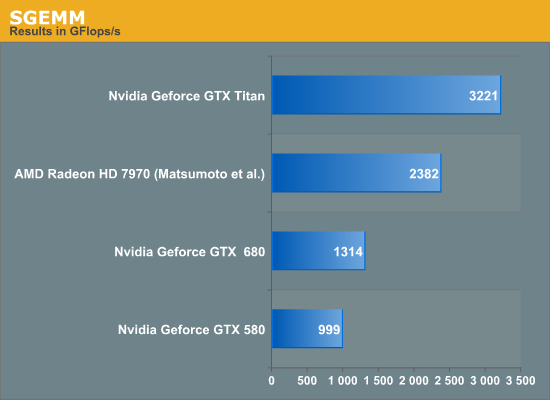
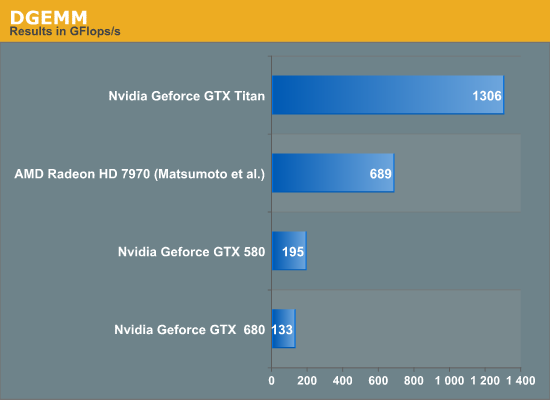
Titan rules the roost amongst the three listed cards in both SGEMM and DGEMM by a wide margin. We have not included Intel's Xeon Phi in this test, but the TItan's achieved performance is higher than the theoretical peak FLOPS of the current crop of Xeon Phi. Sharp-eyed readers will have observed that the Titan achieves about 1.3 teraflops on DGEMM, while the listed fp64 theoretical peak is also 1.3 TFlops; we were not expecting 100% of peak on the Titan in DGEMM. NVIDIA clarified that the fp64 rating for the Titan is a conservative estimate. At 837MHz, the calculated fp64 peak of Titan is 1.5 TFlops. However, under heavy load in fp64 mode, the card may underclock below the listed 837MHz to remain within the power and thermal specifications. Thus, fp64 ALU peak can vary between 1.3 TFlops and 1.5 TFlops and our DGEMM results are within expectations.
Next, we consider the percentage of fp32 peak achieved by the respective SGEMM implementations. These are plotted below.
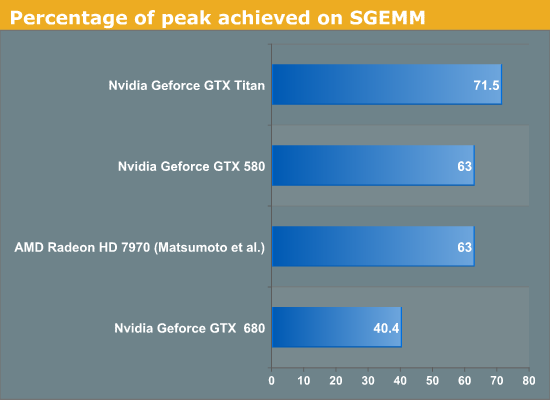
Titan achieves about 71% of its peak while GTX 680 only achieves about 40% of the peak. It is clear that while both GTX 680 and Titan are said to be Kepler architecture chips, Titan is not just a bigger GTX 680. Architectural tweaks have been made that enable it to reach much higher efficiency than the GTX 680 on at least some compute workloads. GCN based Radeon 7970 obtains about 63% of peak on SGEMM using Matsumoto et al. algorithm, and Fermi based GTX 580 also obtains about 63% of peak using CUBLAS.
For FFT, we tested the performance of 1D complex-to-complex inplace transforms of size 225 using the CUFFT library. Results are given below.
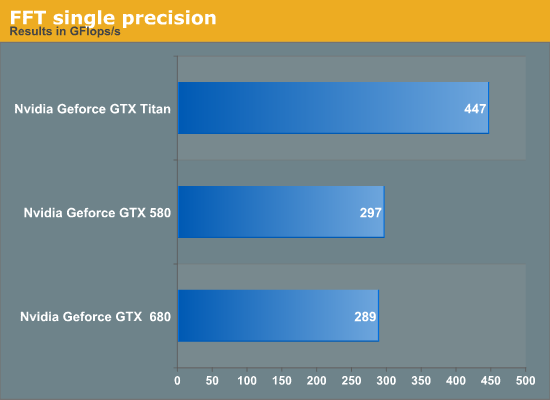
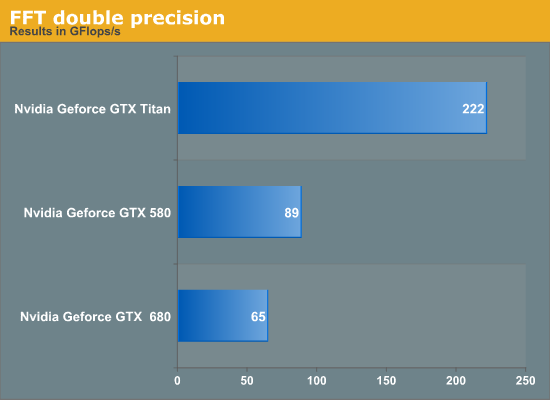
Titan outperforms the GTX 680 in FFT by about 50% in single-precision. We suspect this is primarily due to increased memory bandwidth on Titan compared to GTX 680 but we have not verified this hypothesis. GTX 580 has a slight lead over the GTX 680. Again, if time permits, we may return to the benchmark for a deeper analysis. Titan achieves about 3.4x the performance of GTX 680 but this is not surprising given the poor fp64 execution resources on the GTX 680.
We then looked at an in-house benchmark called SystemCompute, developed by our own Ian Cutress. The benchmark tests the performance on a variety of sample kernels that are representative of some scientific computing applications. Ian described the CPU version of these benchmarks in a previous article. Ian wrote the GPU version of the benchmarks in C++ AMP, which is a relatively new GPGPU API introduced by Microsoft in VS2012.
Microsoft's implementation of AMP compiles down to DirectCompute shaders. These are all single-precision benchmarks and should run on any DX11 capable GPU. The benchmarks include 2D and 3D finite difference solvers, 3d particle movement, n-body benchmark and a simple matrix multiplication algorithm. Boost is enabled on both the Titan and GTX 680 for this benchmark. We give the score reported by the benchmark for both cards, and report the speedup of the Titan over 680. Speedup greater than 1 implies Titan is faster, while less than 1 implies a slowdown.
| Benchmark | GTX 580 | GTX 680 | GTX Titan |
Speedup of Titan over GTX 680 |
| 2D FD | 9053 | 8445 | 12461 | 1.47 |
| 3D FD | 3133 | 3827 | 5263 | 1.37 |
| 3DPmo | 41722 | 26955 | 40397 | 1.49 |
| MatMul | 172 | 197 | 229 | 1.16 |
| nbody | 918 | 1517 | 2418 | 1.59 |
The benchmarks show between 16% and 60% improvement, with the most improvement coming from the relatively FLOP-heavy n-body benchmark. Interestingly, GTX 580 wins over the Titan in 3DPMo and wins over the 680 in 3DPmo and 2D.
Overall, GTX Titan is an impressive accelerator from compute perspective and posts large gains over its predecessors.










337 Comments
View All Comments
Alucard291 - Friday, March 8, 2013 - link
And once again you spew your b/s out of every orifice.But you still haven't said why you think your walls of nonsense make any difference :)
To 4chan with ya
CeriseCogburn - Sunday, February 24, 2013 - link
You people literally are pathetic. Right now, the cheapest gtx 670 is $720 sli, right ?Get your sli motherboard, get ready for extra heat, a better PS ( already stated botiques are launching these with 450W PS.
So how many months after 670 launch with reduced prices are you only 25% off the single fastest video card in the world, while you take the cheapest version you can find ?
You people are seriously filling your diapers at an unbelievable rate.
I'll note once again for all you fools who continuously missed it, and still do, because of course, your gigantic flapping lips wraped around the gourd so many times they sealed off oxygen flow to the brain that you not only don't want to face reality, but choose not to on purpose:
There was a manufacturing shortage for die space in Jan 2012 when 79xx did a near paper launch. Availability for that card was short till a day before the small in comparison 680 die hit the shelves far over half a year later, and the SINGLE factory in the entire world for production was busily building out well over 2 BILLION in emergency production space desperately trying to keep up with bare minimum demands.
THERE WAS NO CAPACITY to produce a 7.1B transistor chip. The design of the chips follows a very slow SEVERAL YEAR slog, and even now, yield on the most complex chip ever is no doubt too low for comfort, and far too low to have been "launched" WHEN YOU IDIOT TIN FOIL HAT WEARING CHARLIE D BUTT KISSING MIND SLAVE FOOLS claim the conspiracy against all gamers was undertaken by "the greedy nVidia".
You people suck.
ronin22 - Thursday, February 21, 2013 - link
Common, stupid..If you are expecting a gaming card, go buy your AMD whatever.
The real magic of Titan is its compute power.
You were stupid to expect anything else from a GK110
CeriseCogburn - Saturday, February 23, 2013 - link
Good to know amd absolutely failed to produce a top end videocard and has stuck all you tards with their only release, a mid range, at $579+ in comparison.
Be a mid ranger, buy amds flagship, the half mast loser card mid range.
piiman - Saturday, February 23, 2013 - link
Come on it's priced , for now, for the Geeks that have to have the biggest most bad ass card out. It will come down once those suckers...oops I mean enthusiast are sucked dry. :-)CeriseCogburn - Saturday, February 23, 2013 - link
Since amd is a sucked dry shriveling corpse (excellent fanboy mistreatment by the tightwad whining poorboy amd penny pinching freaks), your theory, if we give a single deformed brain cell of credit to the amd fanboys, when they wail without amd everything will be a thousand bucks, may not pan out.AMD is dying, and when gone, a thousand bucks will be standard, right all you amd fanboys ?
Start getting used to it.
L O L
atlr - Thursday, February 21, 2013 - link
Agreed. I was hoping for an initial price somewhat proportional to the performance like US$700. Perhaps ebay will be flooded with enough 680's and 690's from the early 'ticket' buyers which will cause retail prices of the same to drop.wongwarren - Thursday, February 21, 2013 - link
Guess you guys didn't read the article properly:With a price of $999 Titan is decided out of the price/performance race; Titan will be a luxury product, geared towards a mix of low-end compute customers and ultra-enthusiasts who can justify buying a luxury product to get their hands on a GK110 video card.
Alucard291 - Thursday, February 21, 2013 - link
Wait wait wait, a GPU is now a luxury product?There was me thinking that all pc components have long since become commodities...
JeffFlanagan - Thursday, February 21, 2013 - link
I agree that talk of a luxury GPU seems odd. Is there any game that will actually look better with this card rather than a $400 card?It may allow the user to up the resolution, but is anyone even shipping textures with detail beyond 1080p these days?
I haven't bought a video card in several years, and can still select Ultra settings on new games at 1080p.